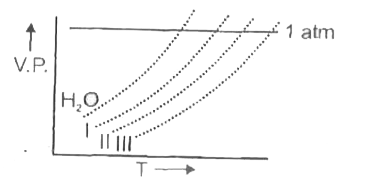Assertion (A): When glucose is added to water, an elevation in boiling point is observed.
Reason (R): The lowering of vapour pressure causes elevation in the boiling point.
Both Assertion (A) and Reason (R) are true and Reason (R) is the correct explanation of the Assertion (A).
Both Assertion (A) and Reason (R) are true , but Reason (R) is not the correct explanation of the Assertion (A).
Assertion (A) is true, but Reason (R) is false.
Assertion (A) is false, but Reason (R) is true.
To solve the question, we need to analyze the assertion and reason provided.
Step 1: Analyze the Assertion (A)
The assertion states: "When glucose is added to water, an elevation in boiling point is observed."
- Explanation: This statement is true. When a non-volatile solute like glucose is dissolved in a solvent like water, the boiling point of the solution increases compared to the pure solvent. This phenomenon is known as boiling point elevation, which is a colligative property.
Step 2: Analyze the Reason (R)
The reason states: "The lowering of vapor pressure causes elevation in the boiling point."
- Explanation: This statement is also true. When a non-volatile solute is added to a solvent, the vapor pressure of the solvent decreases. According to Raoult's law, the presence of a solute reduces the number of solvent molecules at the surface, which lowers the vapor pressure. Since boiling occurs when the vapor pressure equals the atmospheric pressure, a decrease in vapor pressure means that a higher temperature (elevation in boiling point) is required to reach that pressure.
Step 3: Determine the Relationship Between A and R
Now we need to determine if the reason correctly explains the assertion.
- Explanation: While both statements are true, the reason does not directly explain the assertion. The assertion is about the elevation of the boiling point, while the reason discusses the lowering of vapor pressure. The relationship is that the lowering of vapor pressure leads to the elevation of boiling point, but it does not serve as a direct explanation of the assertion itself.
Conclusion
Based on the analysis:
- Assertion (A) is true.
- Reason (R) is true, but it is not the correct explanation of (A).
Thus, the correct answer is: A is true, R is false.
The assertion states: "When glucose is added to water, an elevation in boiling point is observed."
The reason states: "The lowering of vapor pressure causes elevation in the boiling point."
Now we need to determine if the reason correctly explains the assertion.
Based on the analysis:
- Assertion (A) is true.
- Reason (R) is true, but it is not the correct explanation of (A).
Topper's Solved these Questions
Similar Questions
Knowledge Check
Assertion (A) When NaCl is added to water a depression in freezing point is observed.
Reason (R ) The lowering of vapour pressure of a solution causes depression in the freezing point.AAssertion and reason both are correct statements and reason is correcft explanation for assertion.BAssertion and reason both are correct statements but reason is not correct explanation for assertion.CAssertion is correct statement but reason is wrong statement.DAssertion and reason both are incorrect statements.Assertion (A) When NaCl is added to water a depression in freezing point is observed.
Reason (R ) The lowering of vapour pressure of a solution causes depression in the freezing point.AAssertion and reason both are correct statement and reason is correct explanation for assertion.BAssertion and reason both are correct statements but reason is not correct explanation for assertion.CAssertion is correct statement but reason is wrong statement.DAssertion and reason both are incorrect statements.Assertion (A) When NaCl is added to water a depression in freezing point is observed.
Reason (R ) The lowering of vapour pressure of a solution causes depression in the freezing point.AAssertion and reson both are correct statements and reson is sorrect explanation for assertion.BAssertion and reson both are correct statements but resons is not correct explanation for assertion.CAssertion and reason both are incorrect statements.DAssertion is wrong statement but reason is correct statement.
The elevation in boiling point would be highest for
View SolutionCorrect expression for elevation in boiling point is :
View SolutionThis section contains Assertion and Reason type question. Each question have 4 choices (1), (2), (3) and (4), out of which only one is correct
Assertion (A) When methyl alchol is added to water, boiling point of water decreases.
Reason (R) When a volatile solute is added to a volatile solvent elevation in boiling point is observed.
View SolutionWhich solution will show maximum elevation in boiling point?
View Solution
Which is having highest elevation in boiling point?
View Solution
